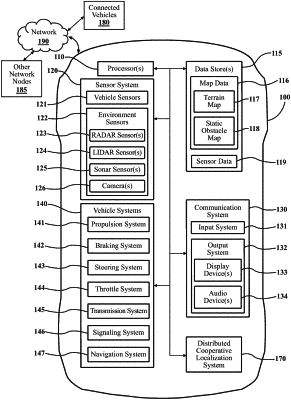| CPC G08G 1/0968 (2013.01) [H04Q 9/00 (2013.01); H04W 4/46 (2018.02); G01S 13/931 (2013.01); G01S 19/03 (2013.01); G01S 2013/9316 (2020.01); G01S 2013/9323 (2020.01); G01S 2013/9324 (2020.01); H04Q 2209/40 (2013.01)] | 20 Claims |

|
1. A system for distributed cooperative localization in a connected vehicular platform, the system comprising:
one or more sensors installed on a first sensor-rich vehicle;
one or more processors in the first sensor-rich vehicle; and
a memory in the first sensor-rich vehicle communicably coupled to the one or more processors and storing:
a first plurality of instructions that when executed by the one or more processors cause the one or more processors to:
receive, from a second sensor-rich vehicle with which the first sensor-rich vehicle is in direct vehicle-to-vehicle (V2V) communication, an estimated location of the first sensor-rich vehicle and a first confidence level associated with the estimated location of the first sensor-rich vehicle;
estimate a location of the second sensor-rich vehicle based on first sensor data from the one or more sensors and assign a second confidence level to the estimated location of the second sensor-rich vehicle;
transmit, to the second sensor-rich vehicle via direct V2V communication, the estimated location of the second sensor-rich vehicle and the second confidence level assigned to the estimated location of the second sensor-rich vehicle; and
a second plurality of instructions that when executed by the one or more processors cause the one or more processors to:
accept, based on communication between the first and second sensor-rich vehicles and predetermined acceptance criteria, an assignment to perform localization for a legacy vehicle;
estimate a location of the legacy vehicle based on second sensor data from the one or more sensors; and
transmit, to the legacy vehicle, the estimated location of the legacy vehicle.
|